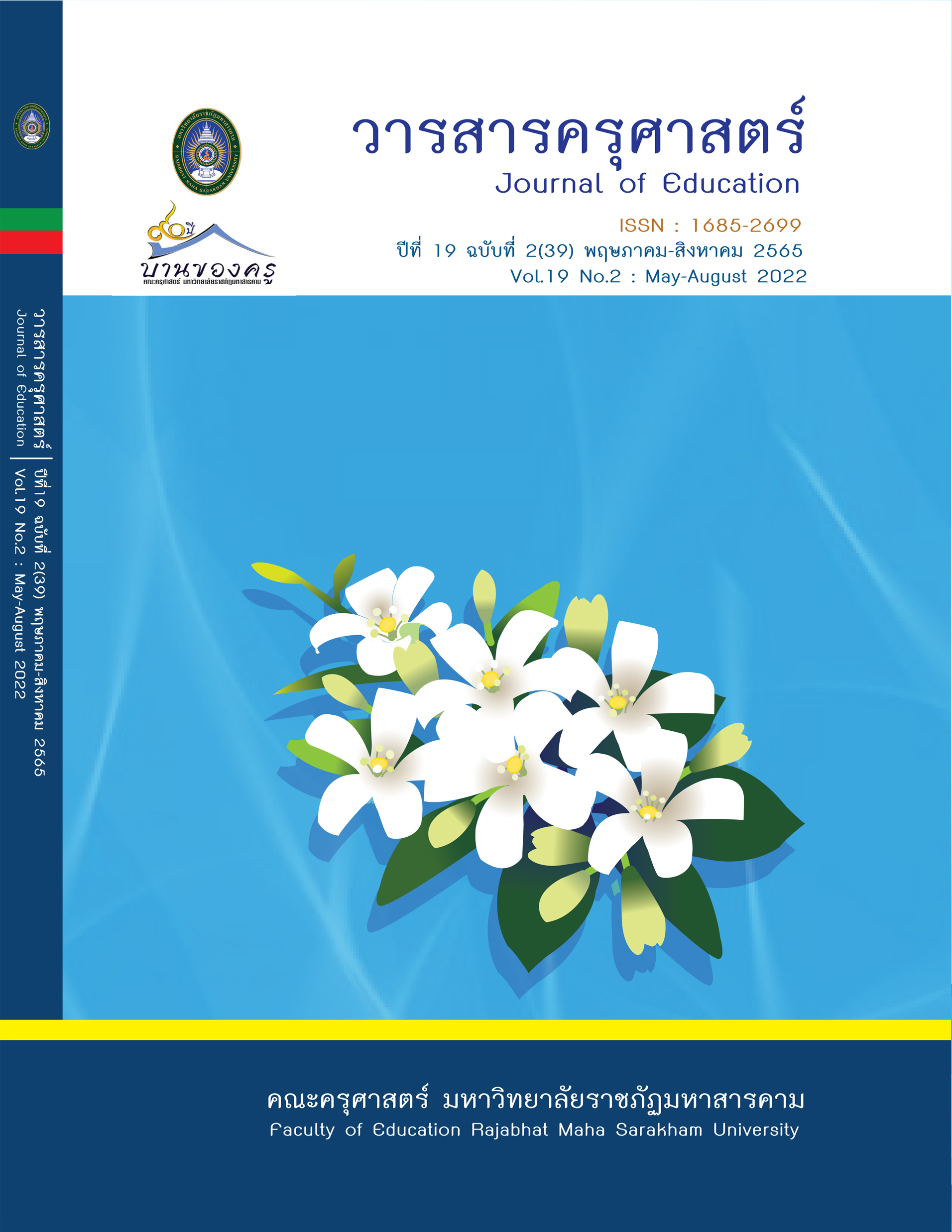The development of blended-learning based on Connectivism theory to promote the creative thinking for Mathayomsuksa 2
Main Article Content
Abstract
The purposes of this research were: (1) to develop the blended-learning based on Connectivism theory to promote the creative thinking for Mathayomsuksa 2 (2) to compare the ability of creative thinking between before and after learning using the blended-learning based on Connectivism theory to promote the creative thinking for Mathayomsuksa 2 and (3) to study the students satisfaction with the blended-learning based on Connectivism theory to promote the creative thinking for Mathayomsuksa 2. The samples of the study were 48 Mathayomsuksa 2 students at Chumchonnonghinwittayakhan school, Nongkungsri District, Kalasin Province, selected by cluster sampling method. The research instruments were 1) learning management plan, 2) Torrance’s Creative Thinking Tests, and 3) the questionnaire of student’s satisfaction. The data were analyzed by mean and standard deviation.
The conclusion of the study were as follows: 1) The development of blended-learning based on Connectivism theory to promote the creative thinking was at the high level ( = 4.30, S.D. = 0.60). 2) The ability of creative thinking after learning through the blended-learning based on Connectivism theory was significantly higher than the pretest score at .05 significant levels. 3) The students' satisfaction with the blended-learning based on Connectivism theory to promote the creative thinking was at the high level ( = 4.28, S.D. = 0.83)
Article Details

This work is licensed under a Creative Commons Attribution-NonCommercial-NoDerivatives 4.0 International License.
ข้อกำหนดเบื้องต้นที่ผู้นิพนธ์(ผู้ส่งบทความ) ควรทราบ
1. ผู้นิพนธ์ที่ประสงค์จะลงตีพิมพ์บทความกับวารสาร ตั้งแต่เดือนมกราคม 2563 เป็นต้นไป ให้ใช้รูปแบบใหม่ (Template 2563) โดยสามารถดูตัวอย่างได้ที่เมนู GUIDELINES
2. จะตีพิมพ์และเผยแพร่ได้ ต้องผ่านการประเมินจากผู้ทรงคุณวุฒิ (Peer Review)
3. การประเมินบทความโดยผู้ทรงคุณวุฒิ (Peer Review) เป็นแบบ Double Blind
4. การอ้างอิงบทความใช้หลักเกณฑ์ APA (American Psychological Association) คลิก
5. บทความถูกปฏิเสธการตีพิมพ์ ไม่ผ่านการประเมิน ผู้นิพนธ์ขอยกเลิกเองหรือชำระเงินก่อนได้รับการอนุมัติ ทางวารสารไม่มีนโยบายการคืนเงิน
References
กรมวิชาการ กระทรวงศึกษาธิการ. (2545). หลักสูตรการศึกษาขั้นพื้นฐาน พุทธศักราช 2545.
องค์การรับส่งสินค้าและพัสดุภัณฑ์.
ขจรพงษ์ ร่วมแก้ว. (2560). การพัฒนารูปแบบการเรียนรู้แบบเปิดตามแนวคิดคอนเน็ตติวิสต์ซึมเพื่อส่งเสริมความคิด
สร้างสรรค์สำหรับนักเรียนระดับปริญญาตรี. [วิทยานิพนธ์ปริญญาดุษฎีบัณฑิต]. สำนักวิทยบริการและ
เทคโนโลยีสารสนเทศ มหาวิทยาลัยราชภัฏมหาสารคาม.
จิราภรณ์ ศิริทวี. (2554). เผยเด็กไทยขาดทักษะการใช้ชีวิต แถมคิดเองไม่เป็น.
http://www2.manager.co.th/Entertainment/ViewNews.aspx.
ทิศนา แขมมณี. (2555). ศาสตร์การสอน: องค์ความรู้เพื่อการจัดกระบวนการเรียนรู้ที่มีประสิทธิภาพ.
สำนักพิมพ์จุฬาลงกรณ์มหาวิทยาลัย.
นพวรรณ ทะวะลัย. (2561). การพัฒนาบทเรียนบนเว็บตามหลักการสภาพแวดล้อมทางการเรียนรู้แบบเปิด (OLEs)
ที่ส่งเสริมความคิดสร้างสรรค์สำหรับนักเรียนชั้นมัธยมศึกษาปีที่ 3. วารสารมหาวิทยาลัยราชภัฏ
มหาสารคาม, 223-233.
ปริญญา บรรณเภสัช. (2557). การพัฒนารูปแบบการเรียนเชิงอิเล็กทรอนิกส์ 8E ตามแนวคิดคอนเน็คติวิซึม
สำหรับนักศึกษาระดับปริญญาตรี. สำนักพิมพ์มหาวิทยาลัยเกษตรศาสตร์.
ภัทร อภิวัฒนกลุ และณาคิน เหลืองนวล. (2558). ความคิดสร้างสรรค์ปัจจัยสร้างอํานาจต่อรองในเวทีโลก. http://www.komchadluek.net/detail/20150817/211741. Html.
ยืน ภู่สุวรรณ. (2556). เทคโนโลยีอุบัติใหม่ ความท้ายทายต่อการเปลี่ยนแปลง.
http://medai.thaicyberu.go.th/strem/ncc2013/.
รัชดา ปุญญา. (2563). การส่งเสริมความคิดสร้างสรรค์ โดยการจัดการเรียนรู้แบบเปิดตามแนวคอนเน็ตติวิซึม
สำหรับนักเรียนชั้นประถมศึกษาปีที่ 5/1 โรงเรียนแก่นนครวิทยาลัย [วิทยานิพนธ์ครุศาสตรมหาบัณฑิต
ไม่ได้ตีพิมพ์]. สำนักวิทยบริการและเทคโนโลยีสารสนเทศ มหาวิทยาลัยราชภัฏมหาสารคาม.
ศูนย์วิจัย มหาวิทยาลัยกรุงเทพ. (2555). ความคิดสร้างสรรค์กับการพัฒนาประเทศ.
http://bangkokpoll.bu.ac.th/poll/result/poll577.php?pollID=436.
สมบัติ กุสุมาวลี. (2559). แนวทางการบริหารจัดการและการพัฒนาทรัพยากรมนุษย์และองค์การใน
อุตสาหกรรมเชิงสร้างสรรค์. วารสารการพัฒนาทรัพยากรมนุษย์และองค์กร, 8(1), 23-59.
สมิต สัชฌุกร. (2553). เทคนิคการประสานงาน (พิมพ์ครั้งที่ 2). วิญญูชน.
อภิสิทธิ์ ธงไชย. (2557). เรื่องเล่าจากงานประชุม ITEEA ครั้งที่ 76. วารสารสถาบันส่งเสริมการสอนวิทยาศาสตร์
และเทคโนโลยี (สสวท.), 42(189), 54-56.
De, B. and Edward .(1982). Lateral Thinking: A Text book of Creativity. Harondswort : Penquin Book.
Kop, R. (2011). The Challenge to Connectivist Learning on Open Online Networks: Learning Experiences during
a Massive Open Online Course. The International review of research in Open and Distance Learning, 12
(3), 1-17.
Kryczka, M. K. (2014). The graduate student learning experience in online, Hybrid, and Onsite Courses.
College of Professional Studies Northeastern University Boston. Massachusetts.
Torrance, P. E. (1965). Rewarding Creative Behavior Engle Wood Cliffs. Prentice Hall.


